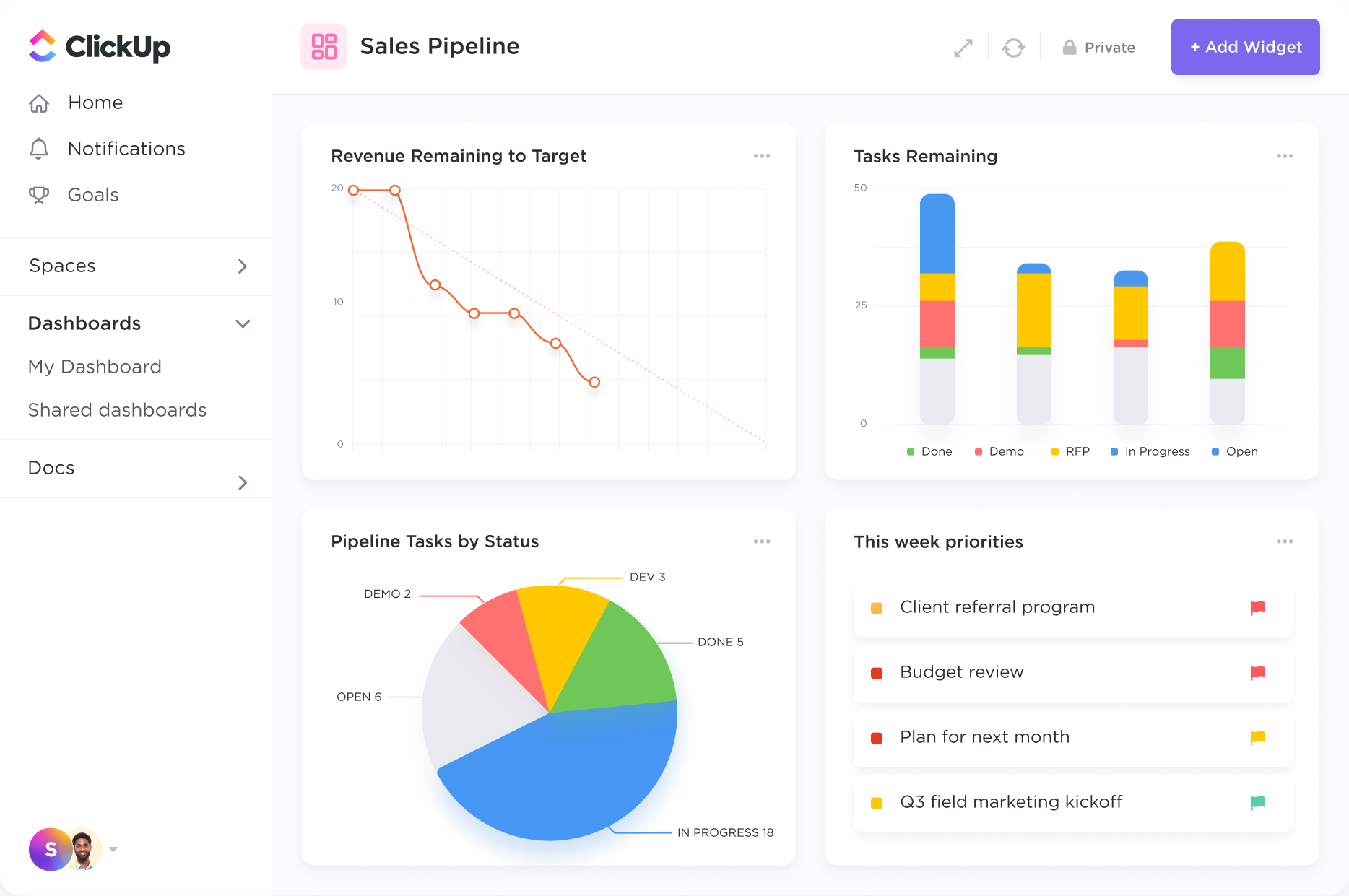CRM Views
See client relationships at a glance.
Manage everything from sales pipelines, customer engagement, and orders with ClickUp's 10+ highly flexible views. Easily track and manage your accounts on a List, Kanban Board, Table view, and more.

Gantt Charts
Revolutionize your restaurant's customer relationships with ClickUp's customizable CRM system. Streamline reservations, track customer preferences, and boost loyalty effortlessly. Say goodbye to manual tasks and hello to a more efficient and personalized dining experience for your customers.
Free forever. No credit card.
CRM Views
Manage everything from sales pipelines, customer engagement, and orders with ClickUp's 10+ highly flexible views. Easily track and manage your accounts on a List, Kanban Board, Table view, and more.

Performance Dashboards
Create high-level views to monitor customer lifetime value, average deal sizes, and more. ClickUp's 50+ Dashboard widgets make it easy to visualize all of your customer data in one place.

Customer Behavior Analysis: Understand how customers interact with the restaurant, such as popular menu items or peak dining times, to tailor offerings and improve customer experience.
Performance Dashboards: Monitor key metrics like table turnover rate or customer satisfaction scores in real-time to make data-driven decisions and optimize operations.
Segmentation Analysis: Identify customer segments based on dining preferences or frequency of visits to create targeted marketing campaigns and loyalty programs.
Lead Tracking and Qualification: Capture leads from reservations or inquiries, score them based on likelihood to dine again, and nurture them through personalized promotions or follow-ups.
Pipeline Management: Visualize where potential bookings stand in the reservation process, helping staff prioritize follow-ups and ensure a fully booked restaurant.
Sales Forecasting: Utilize historical data to predict future reservations, assist in staffing decisions, and plan for busy periods effectively.
Ticketing System: Manage customer feedback or complaints efficiently by assigning tickets to staff, tracking resolutions, and ensuring diners leave satisfied.
Customer Self-Service: Provide easy access to FAQs, menu information, or reservation options online to enhance customer experience and reduce staff workload.
Feedback Collection and Management: Gather feedback on dishes, service, or overall experience to continuously improve restaurant operations and customer satisfaction.
Campaign Management: Launch targeted campaigns for special events, holidays, or promotions to drive reservations and increase customer engagement.
Email Marketing: Automate personalized reservation reminders, feedback requests, or special offers to keep diners informed and coming back.
Customer Segmentation: Segment customers based on dining preferences or frequency to send tailored promotions or loyalty rewards, increasing customer retention.
Centralized Database: Maintain a database of customer preferences, dietary restrictions, or special occasions to provide personalized service and build long-term relationships.
Interaction Tracking: Log interactions with regular diners, such as favorite dishes or past celebrations, to create memorable experiences and foster customer loyalty.
Relationship Mapping: Identify connections between guests dining together or repeat reservations to offer group discounts or personalized recommendations, enhancing customer satisfaction.
A CRM system can help restaurants efficiently manage customer reservations by storing all reservation details in one place, tracking customer preferences, special requests, and visit history. This ensures a personalized experience for diners and helps in optimizing table allocations.
CRMs can gather and analyze customer feedback and reviews from various platforms to identify trends, preferences, and areas for improvement. This data can help restaurants make informed decisions to enhance customer satisfaction and refine their offerings.
By segmenting customers based on dining preferences, frequency of visits, or special occasions, CRM software enables restaurants to send targeted promotions, discounts, or special offers. This personalized approach can increase customer engagement and loyalty.
CRMs can assist restaurants in managing inventory levels, tracking ingredient usage, and establishing relationships with suppliers. By optimizing inventory, restaurants can reduce waste, control costs, and ensure they always have the necessary ingredients on hand.
A CRM system can help streamline staff scheduling based on reservations and peak hours, ensuring the right number of employees are scheduled for efficient operations. Additionally, it can track staff training and certifications, ensuring compliance with industry standards.
Key features of CRM software for restaurants include customer database management, reservation and order tracking, personalized marketing campaigns, feedback collection, and loyalty program management.
CRM software can help restaurants streamline their reservation and booking processes by providing a centralized system to manage all reservations, easily track customer preferences, automate reminders, and optimize table allocation to enhance overall customer experience and operational efficiency.
Best practices for using CRM software in the restaurant industry include personalizing customer interactions, tracking dining preferences and habits, sending targeted promotions and offers, collecting feedback for continuous improvement, and leveraging data analytics to understand customer behavior and enhance loyalty programs.